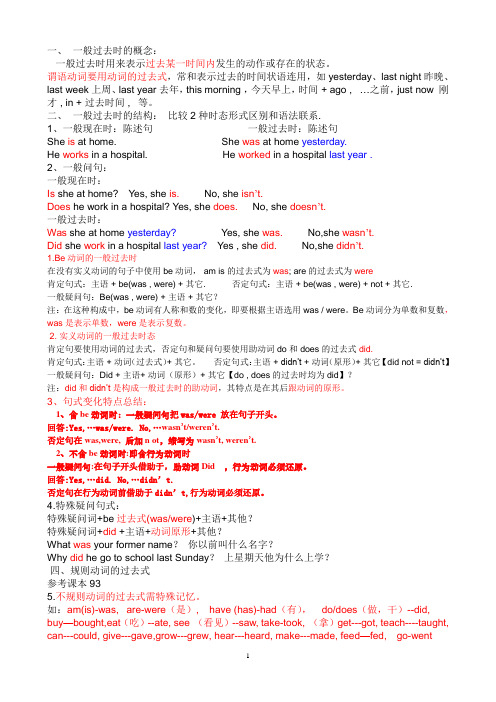五 一般过去式的陈述句和否定句
- 格式:docx
- 大小:11.82 KB
- 文档页数:1


小升初语法专项集训-一般过去时一、一般过去时的定义一般过去时是表示过去某个时间里发生的动作或状态,或过去习惯性、经常性的动作、行为。
常用的时间特征词有:yesterday,yesterday morning,yesterday afternoon,yesterday evening,the day before yesterday(前天),last night,last week,last month,last year,a moment ago(刚才),just now(刚才),two days ago,a week ago,in 1990等。
二、句子结构(1)一般过去时的肯定陈述句:主语+ 动词过去式+ 宾语或表语。
例如:He worked in Shanghai ten years ago.(2)一般过去时的否定句:a.主语+ didn`t + 动词原形+ 宾语。
(did + not = didn't)He didn't do morning exercises yesterday.b.主语+ wasn`t/weren`t +表语。
(was + not = wasn't were+ not = weren't)He wasn't an English teacher ten years ago.(3)一般过去时的一般疑问句:a. Did + 主语+ 动词原形+ 宾语? 例如:Did you study English in 1990 ?b. Was/Were + 主语+ 表语? 例如:Was he a pupil five years ago ?(4)一般过去时的特殊疑问句:a.特殊疑问词+ did + 主语+ 动词原形+ 宾语? 例如:What did you do last Sunday?b.特殊疑问词+ were/was + 表语? 例如:Who was at the zoo yesterday?三、规则动词过去式变化规则一、写出下列单词的过去式。

英语时态表英语时态根据动作发生的时间可分为现在、过去、将来和过去将来四种形式,动作发生 的方式可分为一般、完成、进行和完成进行四种形式,根据自由组合方式可以形成以下16 种 时态,最常用的为一般现在时、一般过去时、一般将来时、过去将来时、现在进行时、过去 进行时、将来进行时、现在完成时、过去完成时、将来完成时、现在完成进行时和过去完成 进行时 12 种时态,其余 4 种很少用。
一、一般现在时主要用法标志性词语常见结构常见句型(1)陈述句:be 动词用 am/i s /a r e 表示,之后接名词,形容词或介词。
(2)否定句:She i s no t ve ry beaut i fu l . They a re no t in the o f f i ce .every…(1)陈述句:行为动词原形或动(2)否定句:词第三人称单数I don’t l ike t he food in KFC.Davy doesn’t l ike t he food in KFC e i t her . (3)一般疑问句: Does she l ive near thesubway s ta t ion?二、一般过去时标志性词语常见结构(1)陈述句: I was a b ig boss .He was beau t i fu l . W e were in Be i j ing las t yea r . (2)否定句: I was no t a t home a t tha t mo ment . (3)一般疑问句: W as she in the o f f i ce l as t week?(1)陈述句:… ago;行为动词用 V-ed ,陈述句,疑问句和否定句借助于 did ,有 did出现动词用原形。
on/in+过去的时间; They didn’t see me. She l iked Engl i sh a lo t .(3)一般疑问句: Did you go to A mer i ca?三、一般将来时主要用法标志性词语常见结构常见句型tomorrow,任何人称I wi l l never be l i eve you aga in . W e wi l l no t buy a car nex t year . (3)一般疑问句:nex tWil l they l ive a f ive-s ta r ho te l? I’m going to go to Kongkong by a i r .否定句:We are not go ing to buy a house here .(2)一般疑问句:i s /am/are+goingto+V 原形,表示计划打算做什么事情。

一般过去时定义:一般过去时表示在过去的某一时候或某一时间段所发生的事情或存在的状态。
表示过去的时间状语,如yesterday, the day before yesterday, last night, three days ago,just now等等。
构成结构:1一般过去时的肯定陈述句:主语+动词过去式+宾语或表语。
例:I played basketball yesterday. I was 11 years old last year.2 一般过去时的否定陈述句:主语+didn’t+动词原形(行为动词)+宾语。
例:I didn’t play basketball yesterday.主语+wasn’t/weren’t +表语。
例:I wasn’t 11 years old last year.3 一般过去时的一般疑问句:Did+主语+动词原形(行为动词)+宾语?例:Did you play basketball yesterday?(注意在陈述句变成疑问句时,第一人称需变为第二人称,如果是其它人称是不需要变化的)Was/Were +主语+表语?例:Were you 11 years old last year? (注意在陈述句变成疑问句时,第一人称需变为第二人称,如果是其它人称是不需要变化的,而有be动词时,be动词需随主语而变化)4 一般过去时的特殊疑问句:特殊疑问词+did +主语+动词原形(行为动词)+(宾语)?例:What did you do yesterday?特殊疑问词+was/were+主语+(表语)?例:How old were you last year?注意:在一般过去时的句子中,如果使用了助动词did, d idn’t等,尽管主语是第三人称单数,谓语动词也无需再变化。
如:He didn’t go to the cinema last night.动词过去式的规则变化:1.一般情况下,在动词原形后直接加ed:work-- worked ,clean--cleaned2.以不发音的e结尾的词,直接加d:live --lived3 以辅音字母+y结尾的词,变y为i加ed:study--studied4以元音字母+y结尾的词,直接加ed:enjoy--enjoyed ,play--played5 以重读闭音节(辅音+元音+辅音)结尾的词,双写最后的辅音字母+ed:stop--stopped不过许多常用的动词的过去式的变化都是不规则的,这就需要大家花时间逐个去记:have/has -- had,eat--ate, see—saw,am/is—was, are—were, go—went, do—did, take--took, run--ran, lend--lent, sleep--slept,get—got, meet—met, bring—brought, buy—bought, think—thought, say—said,give—gave, put—put, speak—spoke, teach—taught,write—wrote, wake—woke, fall—fell, know—knew等等同步测试:一、写出下列动词的过去式。

一、一般过去时的概念:一般过去时用来表示过去某一时间内发生的动作或存在的状态。
谓语动词要用动词的过去式,常和表示过去的时间状语连用,如yesterday、last night昨晚、last week上周、last year去年,this morning ,今天早上,时间 + ago , …之前,just now 刚才 , in + 过去时间 , 等。
二、一般过去时的结构:比较2种时态形式区别和语法联系.1、一般现在时:陈述句一般过去时:陈述句She is at home. She was at home yesterday.He works in a hospital. He worked in a hospital last year .2、一般问句:一般现在时:Is she at home? Yes, she is.No, she isn’t.Does he work in a hospital? Yes, she does. No, she doesn’t.一般过去时:Was she at home yesterday? Yes, she was. No,she wasn’t.Did she work in a hospital last year? Yes , she did. No,she didn’t.1.Be动词的一般过去时在没有实义动词的句子中使用be动词, am is 的过去式为was; are的过去式为were肯定句式:主语 + be(was , were) + 其它. 否定句式:主语 + be(was , were) + not + 其它.一般疑问句:Be(was , were) + 主语 + 其它?注:在这种构成中,be动词有人称和数的变化,即要根据主语选用was / were。
Be动词分为单数和复数,was是表示单数,were是表示复数。
2. 实义动词的一般过去时态肯定句要使用动词的过去式,否定句和疑问句要使用助动词do和 does 的过去式 did.肯定句式:主语 + 动词(过去式)+ 其它。

【知识梳理1】一般过去时★一般过去时:过去发生的动作或存在的状态。
★表示过去的时间词:yesterday, the day before yesterday, just now, in 1999, this morning last1. be 动词的变化2. 一般过去时句式:肯定句:主语+ 动词过去式+其他 He watched a film yesterday.long long week 3 days agomonth year 2 weeks Sunday5 years3. 一般过去时变化规则:动词过去式变化规则1).一般在动词末尾加-ed,如:pull-pulled, cook-cooked2).结尾是e加d,如:taste-tasted3).末尾只有一个元音字母和一个辅音字母的重读闭音节,应双写末尾的辅音字母,再加-ed,如:stop-stopped4).以“辅音字母+y”结尾的,变y为i,再加-ed,如:study-studied【巩固练习】1.They _______(water)flowers. watered2.Mary and Linda________(study) English together last Saturday. studied3.I________(plan)to America last month. planned4. I ________(get )it. got5. He________(listen ) to his father’s advice.Listened4. 对于不规则变化,需留心记忆不规则变化:原形过去式原形过去式原形过去式原形过去式原形过去式do did go went take took say said drink drank have has eat ate read read keep kept sleep slept sweep swept think thought get got know knew grow grew say said see saw make made meet met come came与going重复,一般可以只说be going to a place。
小升初英语必考40个重点知识点一、动词时态和语态1.一般现在时:一般现在时的基本用法、陈述句、否定句和疑问句的构成。
2.一般过去时:一般过去时的基本用法、陈述句、否定句和疑问句的构成。
3.现在进行时:现在进行时的基本用法、陈述句、否定句和疑问句的构成。
4.将来时:将来时的基本用法、陈述句、否定句和疑问句的构成。
5.一般现在时被动语态:一般现在时被动语态的构成和用法。
6.一般过去时被动语态:一般过去时被动语态的构成和用法。
7.现在进行时被动语态:现在进行时被动语态的构成和用法。
8.一般将来时被动语态:一般将来时被动语态的构成和用法。
二、名词9.可数名词和不可数名词:可数名词和不可数名词的基本概念和区别,以及单数形式和复数形式的构成规则。
10.名词所有格:名词所有格的构成和用法。
三、冠词11.不定冠词:不定冠词的构成和用法。
12.定冠词:定冠词的构成和用法。
四、代词13.主格代词和宾格代词:主格代词和宾格代词的基本用法和形式。
14.物主代词:物主代词的构成和用法。
15.反身代词:反身代词的构成和用法。
16.不定代词:不定代词的构成和用法。
五、形容词和副词17.形容词比较级和最高级:形容词比较级和最高级的构成和用法。
18.副词比较级和最高级:副词比较级和最高级的构成和用法六、动词不定式和动名词19.动词不定式的基本用法和构成:动词不定式作主语、宾语、表语、定语等的用法。
20.动词不定式的被动语态:动词不定式被动语态的构成和用法。
21.动词不定式的完成时态:动词不定式的完成时态的构成和用法。
22.动名词:动名词的基本构成和用法。
七、介词和介词短语23.常见介词和固定介词短语:常见的介词及其基本用法。
八、连词24.并列连词:并列连词的基本用法和构成。
25.从属连词:从属连词的基本用法和构成。
九、情态动词26. can和could:can和could的基本用法和构成。
27. may和might:may和might的基本用法和构成。
一般过去时的变化规则1.一般过去时的陈述句句子结构:主语+动词过去式+其他成分。
例如:I watched a movie last night.(我昨晚看了一部电影。
)2.行为动词的一般过去时变化规则:a. 一般在动词词尾直接加-ed。
例如:walk → walked(走),play → played(玩)。
b. 以字母y结尾的动词,去掉y改为i,再加-ed。
例如:study → studied(学习),cry → cried(哭)。
c. 以重读闭音节结尾的单词,且末尾只有一个辅音字母,则双写该辅音字母,再加-ed。
例如:stop → stopped(停止),plan → planned(计划)。
d. 以辅音字母+y结尾的动词,改变y为i,再加-ed。
例如:carry → carried(携带),try → tried(尝试)。
e.以e结尾的动词,直接加-d。
例如:dance → danced(跳舞),invite → invited(邀请)。
3.不规则动词的一般过去时变化规则:a.一些常见的不规则动词在一般过去时会有不规则的变化形式。
这些形式必须记住。
例如:go → went(去),see → saw(看见),give → gave(给予)。
b.一些不规则动词的过去式和过去分词形式相同。
例如:put → put(放置),cut → cut(切割),hit → hit(打击)。
4. be动词在一般过去时的变化规则:a. be动词的过去式有两个形式,was和were。
例如:I was tired yesterday.(昨天我很累。
)They were late for the meeting.(他们迟到了会议。
)b. was用于第一人称单数(I),第三人称单数(he/she/it),以及单数名词,were用于第二人称单数(you)以及所有人称复数。
例如:She was happy.(她很开心。
)We were at the park.(我们在公园。
一般过去时句型
一般过去时是英语中表示过去发生的动作或状态的一种时态。
以下是一些常见的一般过去时的句型:
1. 肯定句:主语 + 动词过去式(例如:I walked to school yesterday.)
2. 否定句:主语 + did not (didn't) + 动词原形(例如:She didn't go to the party last night.)
3. 疑问句:Did + 主语 + 动词原形?(例如:Did you watch the movie last night?)
4. 特殊疑问句:特殊疑问词 + did + 主语 + 动词原形?(例如:What did you do yesterday?)
5. 简单过去时的时间状语:yesterday, last week, in 2010等(例如:I went to Paris last year.)
6. 简单过去时的被动语态:was/were + 动词的过去分词 (例如:The book was written by Mark Twain.)
7. 简单过去时的完成时态:had + 动词的过去分词 (例如:He had finished his homework before dinner.)
8. 简单过去时的进行时态:was/were + 现在分词 (例如:They were watching TV when
I arrived.)。